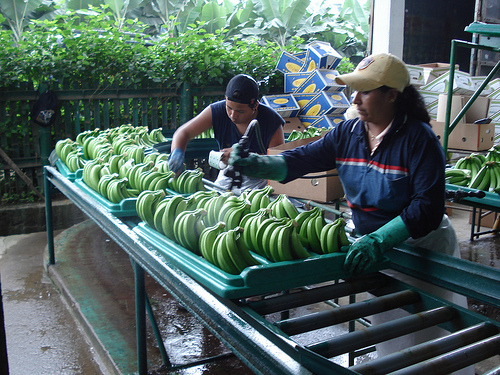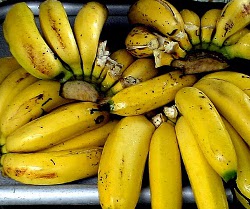 Photo: Frank KehrenFor years journalists have warned of imminent banana extinction. “Get bananas while you still can,” wrote New Scientist over five years ago. “The world’s most popular fruit … is in deep trouble,” it went on to say, adding that the banana would probably be out of supermarkets by 2013, and would soon exist only in backyard gardens and other places the Panama Race IV, a pathogen taking out plantations in Southeast Asia, couldn’t reach.
Photo: Frank KehrenFor years journalists have warned of imminent banana extinction. “Get bananas while you still can,” wrote New Scientist over five years ago. “The world’s most popular fruit … is in deep trouble,” it went on to say, adding that the banana would probably be out of supermarkets by 2013, and would soon exist only in backyard gardens and other places the Panama Race IV, a pathogen taking out plantations in Southeast Asia, couldn’t reach.
But today — just a few years from the banana’s supposed demise — one can walk down the street and find bananas in the nearest corner store, hanging out between the cash register and the lottery tickets. What gives? Are we still heading toward bananapocalypse? Or has it been cancelled? And what can the banana tell us about the evolution of our global food supply?
It turns out that the Race IV fungus does cause a true bananapocalypse. It just hasn’t spread everywhere — yet. Once it shows up on a farm, the land around it can’t be used to grow the same variety for another 30 years. And, given that there’s only one variety of banana — the Cavendish — that ships well enough and tastes good enough to be sold everywhere in the world, this is bad news for banana growers. The arrival of Race IV on your property is a sign that you’ve officially left the international banana trade.
But — to use a horror movie analogy — Race IV moves more like a zombie horde in a ’70s movie than like the sleek, fast-moving zombies of today. In other words, smarter pathogens travel on insects (which can hop rides on ships and airplanes) or float on wind currents like Black sigatoka (the banana’s main nemesis in the Americas), while Race IV travels by dirt, weeds, and water. Twenty years after the first plantations began to fail in Southeast Asia, the fungus has yet to be found in India and the Americas, which remain the most productive Cavendish growing regions in the world.
“It’ll get there,” says Randy Ploetz, a pathologist who researches tropical fruit diseases at the University of Florida. “But it’s really overblown.” In fact, he adds, “We’ve got a banana glut right now.”
A little banana history
 Photo: Andrea GuerraSoutheast Asia was never an ideal place to grow bananas commercially, says Ploetz. Because the banana evolved there, every parasite and pathogen that evolved alongside it is also hanging out there, waiting to attack it.
Photo: Andrea GuerraSoutheast Asia was never an ideal place to grow bananas commercially, says Ploetz. Because the banana evolved there, every parasite and pathogen that evolved alongside it is also hanging out there, waiting to attack it.
Success in the globalized food trade has come to mean planting crops far away from where they evolved, in a climate as similar as possible, and then sitting back and collecting the profits until the pests show up. In the case of the banana, arguably the first globalized fruit, new markets have led to new growing regions. As Japan began to globalize, a few plantations were laid out in Taiwan. And when Saudi Arabia began to import bananas, residents made it clear that they would really prefer their bananas grown in an Islamic country — and suddenly there were plantations in Indonesia and Malaysia too.
Race IV had probably been around for a long time, but it wasn’t until these plantations went in that it had the expansion opportunity that a monoculture provides. It takes anywhere from nine months to several years for plants infected with Race IV to start showing signs of disease. And by the time the plantations in Malaysia began to fail, Race IV had been carried all over Southeast Asia — on weeds, through irrigation channels, and on the tire treads of trucks and the boot soles of workers. It only took five years after Race IV first appeared in Malaysia for the banana industry there to completely collapse. From there it spread to Taiwan, Indonesia, and Australia — though it has yet to reach Cambodia or Vietnam.
It’s all about the variety
The Cavendish came about in the 1960s, when Dole and Chiquita were faced with a milder form of Panama Race IV. The Gros Michel — or “Big Mike” banana — which was the industry standard then, was being undone by what is now known as Panama Race I. So the industry giants made the unprecedented choice to sell the world on a new banana.
It was widely agreed that Big Mike was the better banana. “If you look at old photos,” says Ploetz, “you’ll see workers throwing entire bunches of [Big Mikes] into the back of a car. You can’t do that with a Cavendish.” Also, he says, Big Mike tasted better. But Cavendish was ridiculously productive, and tasted good enough. It cost Chiquita and Dole millions of dollars to rip up and replant their plantations with Cavendish, and to re-engineer their boats, railroad cars, and packing systems to handle the new fruit — but it ensured that the banana would continue to lead the global fruit market, as the *cough* top banana.
 Gros Michel of “Big Mike” bananasPhoto: Wiki Media CommonsBut, here’s the thing: There is no new banana variety waiting in the wings to replace the Cavendish. The E.U. has made it clear that it has no interest in buying a genetically engineered (GMO) banana. Another variety [PDF], produced by cross-breeding samples from more than 350 banana types, was given the astonishingly awesome name of “Goldfinger.” It has sold well in Australia, but doesn’t travel well after harvest in the tropics.
Gros Michel of “Big Mike” bananasPhoto: Wiki Media CommonsBut, here’s the thing: There is no new banana variety waiting in the wings to replace the Cavendish. The E.U. has made it clear that it has no interest in buying a genetically engineered (GMO) banana. Another variety [PDF], produced by cross-breeding samples from more than 350 banana types, was given the astonishingly awesome name of “Goldfinger.” It has sold well in Australia, but doesn’t travel well after harvest in the tropics.
On top of it, the Cavendish is “reproductively-challenged.” So the quest to produce a variety that is resistant to Race IV but tastes, looks, and grows like a Cavendish, is a somewhat Quixotic one. (After putting 400 tons of Cavendish through a sieve, a research team in Honduras managed to extract only 15 seeds.) Since Race IV takes out not only Cavendish, but many other related varieties, the odds don’t look good. Another research team in Taiwan stresses Cavendish plant tissues until they mutate slightly, then grows the resulting plants. They’ve managed to produce a Cavendish which can withstand the Race IV for four years (most banana plants live for about 15 years).
Yes, we have no bananas
In other words: so far, scientists have had no real luck. And unless they do, bananas will stop haunting corn flake bowls and fruit salads around the world. When Race IV reaches today’s prime banana-growing regions, it’s likely to be some combination of homesickness and air travel that does the industry in — a person who takes a shoot from a banana tree in their home country, puts it in a suitcase, and smuggles it into their new home. “It’s going to be some idiot,” says Ploetz. “Someone who goes home to visit their family and says, “Oh, the tree in my parents’ backyard always had the most delicious fruit.”
That said, even if bananas disappear from supermarkets of Ohio, it won’t mean the end of the fruit all together. After all, the Cavendish is only 50 percent of the world banana market. No one is quite sure how many other varieties make up that other half, but it’s estimated to be 1,000.
The 20th century was the era when we saw a few species — the Cavendish, the Russet potato, the Holstein cow — come to dominate world agriculture. The 21st century looks to be the era in which those great monocultures are gradually becoming undone. And while the hordes of other banana varieties may not be as productive, as easy to ship, nor as smooth and unblemished, their sheer difference from one another has the potential to shield them from pathogens carried by the humans who, in this century, travel as far and as readily as crops began to travel in the last one.
Ploetz knows the Gros Michel tastes better than the Cavendish because he’s eaten one. Not in a tightly controlled banana research center, but in a market in Costa Rica, where they’re still grown on small farms and in people’s back yards. The taste is sweeter, he reports. And more complex.



